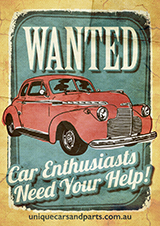BMW E12 528i
Reviewed by Unique Cars and Parts
Our Rating: 2
Introduction
The
BMW E12 5-Series was introduced in
1972 as a European only model, it being the first to bear the 5 Series name: the '5' denoting BMW's fifth 'New Class' platform. Designed as a replacement for the popular
BMW New Class mid-size sedan, the E12 5-Series models were smaller than the large BMW E3 sedan but larger than the two-door
2002 models.
The E12 models were fitted with a variety of engines. 1.8 litre and 2.0 litre M10 4 cylinder engines from the older Neue Klasse sedans were used in the 518 and 520, respectively. A six-cylinder version of the 520, built with a 2.0 litre M20 belt-driven engine was also available from
1977 on (to coincide with the minor restyling).
The 525i, 528i, 530i, and M535i were introduced from
1973 on, and were fitted with the M30 six-cylinder engine as used on the larger E3 sedans and E9 coupes. With the exception of the 520i, four-cylinder and 2.0 litre six-cylinder engines were fitted with Solex carburetors (although in the UK the four-cylinder 520 was fitted with twin Stromberg 175CDET carburettors). The 520i used the mechanical fuel injection system from the BMW 2000tii and BMW 2002tii.
Six-cylinder versions were available with dual Zenith two-barrel carburetors or Bosch L-jetronic fuel injection. Fuel-injected models contain the i letter at the end of their model badge. Although
BMW had always located turn signal stalks on the right hand side of its steering wheels, the E12 was their first model to have the stalk on the left side.
The six cylinder 530i was introduced to the American market in
1974. Road & Track magazine made the 530i one of its Ten Best Cars. The 530i boasted a 176 hp engine, four-speed manual transmission, and a top end of 124 mph. The early US models had several problems including
cylinder head cracking, body rust, and ugly "safety" bumpers.
Several changes were made in
1977 such as improved ventilation, increased sound insulation, electrically operated side mirrors, two-way sunroof, and ventilated front disc brakes. Standard equipment included sport wheels,
air-conditioning, power windows and power steering. From
1975 to
1977, BMW produced a 528i Sedan with twin carburetors for the European market - and it was this car which would eventually make its way to Australia. In August
1977, the fuel injected 528i was introduced with 176 bhp and a Bosch L-Jetronic induction system.
BMW E12 Facelift
In Australia
BMW imported the 528i, and marketed it as a sporty sedan, rather than as a sports car - a subtle distinction maybe, but it did provide an accurate description of what the car offered by way of performance and handling. Of course the 528i's injected 2788cc six cylinder SOHC engine was never a sluggard, but its performance allied to some fine suspension tuning transformed the machine fully into the same sports car class as the smaller 323i. But the 2.8 was considerably faster in a straight line, performing with uncanny smoothness and with just enough of the soft, raucous engine noise percolating through the cabin to make the true driving nut feel completely happy. When it came to handling however, whether on gravel or bitumen, it remained a challenge to find the true limits of adhesion.
On the Road
Early iterations of the E12 5 Series, built from
1972 to mid
1979, were prone to pick up an inside wheel on the limit, but
BMW Australia spent some time fine tuning the suspension, so that by the late 1970s the rear end would no longer make violent moves in mid corner, which in turn would bring about attitude changes which made high demands on the driver. These later versions were superbly balanced, and even entering corners at seemingly suicidal speeds revealed nothing that could be called dramatic in the car's reaction. Most would find it hard to find the ultimate limits of the car's road holding, only getting some intimation by provoking the thing unmercifully.
At the time, and maybe it is still true today, there was a perception by some that cars imported into Australia by many companies were "cast offs" from their home markets, seeing out their production lives in less important global markets. But with the dreaded ADR compliance requirements, manufacturers were forced to ensure their cars were fully up to the task, or they faced the prospect of having some expensive sheet metal gather dust at the dealership. At the time, it was true that the localisation of the
Holden Commodore/
Ford Falcon range established the feeling that Australia's requirements were unique. But good as both were, neither came within a bull's roar of even the original BMW 528i. Nevertheless, the company's Australian engineers went to work on the suspension setup, modifying roll bars, shockers and springs in order to produce the definitive set-up. The result was a car which, according to BMW, was 30% improved over its European counterpart in the suspension area.
Getting it right for Australia
A 2.5mm increase in shock absorber diameter, together with revised valving increased firmness by 15%. The front sway bar, at 24mm, was a millimetre greater in diameter, while 2 millimetres were added to the rear sway bar upping it to 18mm. This produced a 20% improvement in roll stiffness, and yet, oddly enough, ride at low speed and high speed was still perfectly acceptable. Some owners claimed it was a little firm, but the heavy road shocks were very well damped. In addition to the improvements in dynamics,
BMW Australia made a few of the items which were previously optional, standard within the specification of the 3 speed
automatic model. There was a pneumatically controlled central locking system, complete with a mercury override safety switch. The then latest KP 2000 stereo system, with Blaupunkt speakers was standard. Add to these power steering, integrated
air-conditioning and electrically operated remote control external rear view mirrors on either side, and it was obvious that the
1979 528i was something special.
Two models were available. Basic (if that was the right word) came with a manual transmission and was priced at A$25,560. The very comprehensively equipped auto cost A$27,395. That was a considerable amount of money back then – but these cars were built to last, and would retain high resale value too. By
1980 there were just under 12,000 registered BMWs on Australia's roads. Although there were a few private imports, the vast majority of these cars had been brought since 1966 when
BMW began importing them here. 3250 of these were 528i models. While
BMW could never hope to match Holden and Ford for countrywide dealership distribution, there were nevertheless 60 dealerships in Australia, thus assuring owners of the service they demanded. Spares to the value of $3 million were available in 1980, underlining the fact that
BMW took its Australian operations seriously.
BMW’s growth in Australia during this time was lead by Managing Director Ron Meatcham, who believed the maker had the potential to sell up to 16,000 cars each year. But, back then, there were import quota restrictions, import duties and taxes. In
1979 a miracle happened: the first M5 was built for Europe. The M5 had a six cylinder engine with 218 hp and a top speed of 225 kmh/140 mph. The birth of a legend! The E12 was replaced by the BMW E28 5 Series in
1981, although production continued until
1984 in South Africa.



